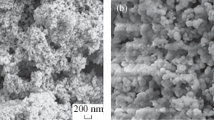Abstract
Charged amino acids such as arginine, lysine, glutamic acid, and aspartic acid are abundant in noncollagenous proteins that regulate mineralization. Synthetic peptide forms of these amino acids have been shown to affect crystal growth in precipitation of mineral crystals in solution. However, little is known about the effects of these peptides on the viability and phenotype of bone marrow stromal cells (BMSCs) or on the in vitro mineralization process. Bone marrow was harvested from neonatal rat femora and cultured under conditions to induce mineralized nodule formation. Mineralized bone nodules were grown while supplementing the cultures with one of five polyelectrolytes: polystyrene sulfonate (PSS), poly-l-glutamic acid (PLG), poly-l-lysine (PLL), poly-l-aspartic acid (PLA), and sodium citrate (SC), as well as a nontreated control group. The viability and the rate of collagen synthesis under the effect of these agents were characterized by cell-counting and dye-binding assays, respectively. Raman microspectroscopy was conducted on mineralized bone nodules to determine the effect of the polyelectrolytes on the mineralization, type-B carbonation, and crystallinity of the mineral phase. Morphology of resulting mineral crystals was investigated using X-ray diffraction line-broadening analysis (XRD). PSS had toxic effects on cells whereas the remaining agents were biocompatible, as the cell viability was either greater (PLG) or not different from controls. The total collagen production by day 21 was 27% and 42% lower than controls for PLL and PSS, respectively. Culture wells stained positively for alkaline phosphatase in the presence of polyelectrolytes, indicating that osteogenic differentiation was not impacted negatively. Raman microspectroscopy revealed that the type-B carbonation of the crystal lattice increased when treated with PLG, PLL, or PSS. Crystallinity of PLL and PSS was smaller than that of control. The mineral/matrix ratios of nodules did not change with polyelectrolyte treatment, with the exception of the PSS-treated group, which was less mineralized. XRD analysis of bone nodules indicated that PLA-treated samples were significantly longer than controls along the 002 direction. Overall, the results suggest that the polypeptides consisting of charged amino acids are biocompatible and that they have the potential to affect crystal quality and morphology in vitro in the presence of cells. However, the mechanisms by which these effects come into play remain to be investigated.
Similar content being viewed by others
References
Akkus O (2005) Elastic deformation of mineralized collagen fibrils: an equivalent inclusion based composite model. J Biomech Eng 127:383–390
Akkus O, Adar F, Schaffler MB (2004) Age-related changes in physicochemical properties of mineral crystals are related to impaired mechanical function of cortical bone. Bone (NY) 34: 443–453
Landis WJ (1995) The strength of a calcified tissue depends in part on the molecular structure and organization of its constituent mineral crystals in their organic matrix. Bone (NY) 16:533–544
Jager I, Fratzl P (2000) Mineralized collagen fibrils: a mechanical model with a staggered arrangement of mineral particles. Biophys J 79:1737–1746
Bigi A, Boanini E, Bracci B, Falini G, Rubini K (2003) Interaction of acidic poly-amino acids with octacalcium phosphate. J Inorg Biochem 95:291–296
Bradt JH, Mertig M, Teresiak A, Pompe W (1999) Biomimetic mineralization of collagen by combined fibril assembly and calcium phosphate formation. Chem Mater 11:2694–2701
Eanes ED, Hailer AW (2000) Anionic effects on the size and shape of apatite crystals grown from physiological solutions. Calcif Tissue Int 66:449–455
Fujisawa R, Wada Y, Nodasaka Y, Kuboki Y (1996) Acidic amino acid-rich sequences as binding sites of osteonectin to hydroxyapatite crystals. Biochim Biophys Acta 1292:53–60
Furedi-Milhofer H, Ofir PBY, Sikiric M, Garti N (2004) Control of calcium phosphate crystal nucleation, growth and morphology by polyelectrolytes. Bioceramics 254(2):11–14
Hunter GK, Goldberg HA (1994) Modulation of crystal-formation by bone phosphoproteins: role of glutamic acid-rich sequences in the nucleation of hydroxyapatite by bone sialoprotein. Biochem J 302:175–179
Ofir PBY, Govrin-Lippman R, Garti N, Furedi-Milhofer H (2004) The influence of polyelectrolytes on the formation and phase transformation of amorphous calcium phosphate. Crystal Growth Design 4:177–183
Romberg RW, Werness PG, Riggs BL, Mann KG (1986) Inhibition of hydroxyapatite crystal-growth by bone-specific and other calcium-binding proteins. Biochemistry 25:1176–1180
Boskey AL (1989) Noncollagenous matrix proteins and their role in mineralization. Bone Miner 6:111–123
Devries A, Feldman JD, Stein O, Stein Y, Katchalski E (1953) Effects of intravenously administered poly-d l-lysine in rats. Proc Soc Exp Biol Med 82:237–240
Hirabayashi H, Nishikawa M, Takakura Y, Hashida M (1996) Development and pharmacokinetics of galactosylated poly-l-glutamic acid as a biodegradable carrier for liver-specific drug delivery. Pharm Res 13:880–884
Akkus O, Polyakova-Akkus A, Adar F, Schaffler MB (2003) Aging of microstructural compartments in human compact bone. J Bone Miner Res 18:1012–1019
Yerramshetty JS, Lind C, Akkus O (2006) The compositional and physicochemical homogeneity of male femoral cortex increases after the sixth decade. Bone (NY) 39:1236–1243
Holden JL, Clement JG, Phakey PP (1995) Age and temperature-related changes to the ultrastructure and composition of human bone mineral. J Bone Miner Res 10:1400–1409
Rego AC, Santos MS, Areias F, Proenca T, Oliveira CR (2001) Glutamate regulates the viability of retinal cells in culture. Vision Res 41:841–851
Tryoen-Toth P, Vautier D, Haikel Y, Voegel JC, Schaaf P, Chluba J, Ogier J (2002) Viability, adhesion, and bone phenotype of osteoblast-like cells on polyelectrolyte multilayer films. J Biomed Mater 60:657–667
Fatokun AA, Stone TW, Smith RA (2006) Hydrogen peroxide-induced oxidative stress in MC3T3-E1 cells: the effects of glutamate and protection by purines. Bone (NY) 39:542–551
Biltz RM, Pellegrino ED (1977) Nature of bone carbonate. Clin Orthop 129:279–292
Penel G, Leroy G, Rey C, Bres E (1998) MicroRaman spectral study of the PO4 and CO3 vibrational modes in synthetic and biological apatites. Calcif Tissue Int 63:475–481
Brown WE, Chow LC (1976) Chemical properties of bone-mineral. Annu Rev Mater Sci 6:213–236
Author information
Authors and Affiliations
Corresponding author
About this article
Cite this article
Dziak, K.L., Akkus, O. Effects of polyelectrolytic peptides on the quality of mineral crystals grown in vitro. J Bone Miner Metab 26, 569–575 (2008). https://doi.org/10.1007/s00774-008-0869-x
Received:
Accepted:
Published:
Issue Date:
DOI: https://doi.org/10.1007/s00774-008-0869-x




